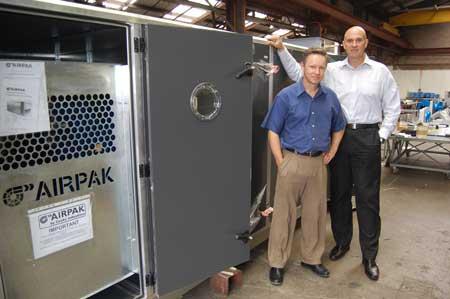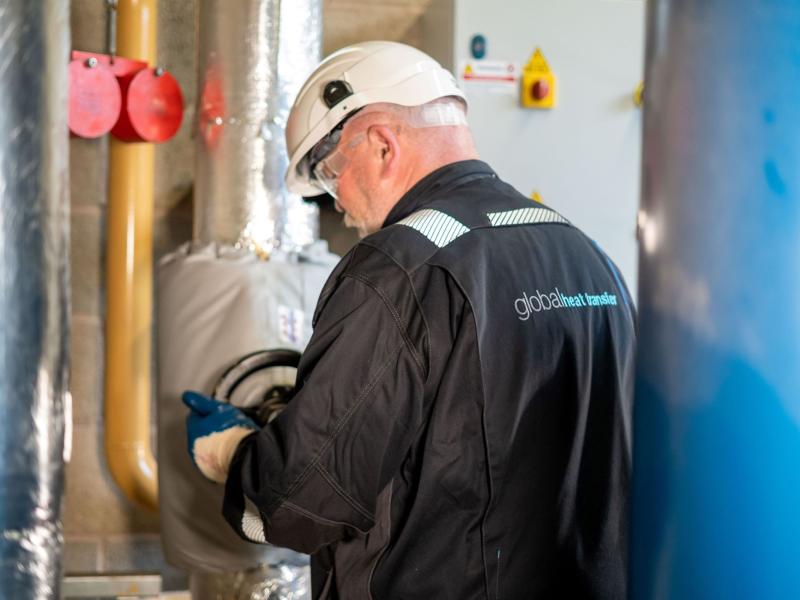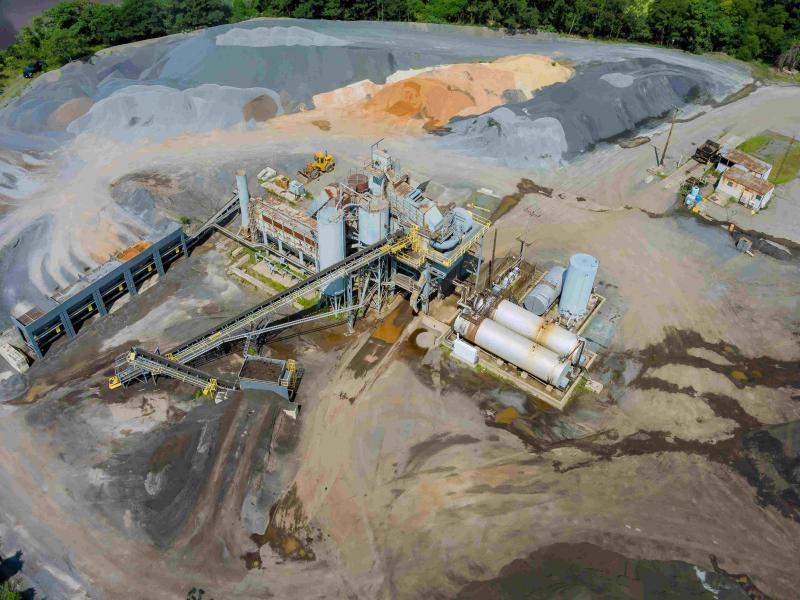With energy costs continually rising, energy efficiency is paid more and more attention in the HVAC sector. Stefan Richter talked to Andrew Cooke, Cooke Industries’ General Manager, about the trend towards more energy-efficient air handling systems.
In a recently-issued press release, Ewan Gebbie of the Energy Management Association of New Zealand (EMANZ) highlighted the importance of a mandatory building energy rating system for this country. The association executive officer estimated the potential savings for New Zealand at about $500 million, based on auditor’s reports which regularly identify available savings of between 30 and 50 percent for commercial buildings. In this context improving the efficiency of heating, ventilation and air conditioning systems constitutes a significant possibility to save energy and money: According to the Energy Efficiency and Conservation Authority (EECA), HVAC equipment generally accounts for about one third of the energy used by commercial buildings.
“Without a mandatory building energy rating system, people intending to buy or rent property have little chance to gauge how one building performs against another in terms of operating costs,” says Andrew Cooke, the General Manager of Cooke Industries Ltd. “When it comes to enforcing energy efficiency, the legislation in our country tends to lag behind that in Australia and Europe.” For example, the National Australian Built Environment Rating System (NABERS) rates a building based on its measured operational impact on the environment, and public buildings in the UK are pressure tested for air leakage and issued with a Display Energy Certificate. Energy-efficient technology, such as HVAC systems, and proper insulation can significantly reduce the impact the building has – and with it the total cost or life cycle cost necessary to operate all its systems. It has been estimated that the energy costs of running equipment is several times higher than the original purchase price and can add up to over 80 percent of the total cost. “A big part of the commercial office development market in New Zealand is driven by the interests of property developers rather than those of potential tenants or end users,” explains Andrew. “A traditional property developer does not care much about the life cycle cost of a building, which includes energy and service costs. They appear to be concerned about the cost of putting the building up. A mandatory rating system would certainly help to change the thinking in this industry.”
From plumbing to air handling
Cooke Industries Limited, part of the Cooke Group founded in 1926 by William L Cooke, is the business unit manufacturing air conditioning, refrigeration, heating, and acoustic products for the commercial, institutional, and industrial markets. From the original Cooke business specialising in plumbing and heating installations, the business has expanded to include sheet metal working, ventilating and air conditioning. “We have been dealing with air handling products for over 40 years now,” recalls Andrew Cooke, “Back in the 1970s, we had problems sourcing suitable locally-manufactured products, and there were too many restrictions in place for imported items. It was then that we started manufacturing our own Airpak range of air handling products. Over this period we have grown to become a dominant player in the market, and we pride ourselves on being the leading supplier of air handling units for the commercial and industrial sectors in New Zealand.” The company’s products are installed in hospitals, universities, prisons, production facilities, pharmaceutical companies and commercial buildings throughout the country.
Cooke Industries’ air handling product range includes air handling units, fan coil units, centrifugal fans, air heaters, heat recovery products and ductwork. “Our air handling units come in 25 standard sizes, with four different options of construction for each size, and we have a standard solution for every air treatment requirement such as filtration, humidification, dehumidification, heating, cooling, and energy recovery,” explains Andrew, “But many of the air handling units we build are uniquely customised to suit the customer’s special application requirements.”
How to increase the efficiency of a HVAC system
HVAC systems provide filtered air, heating, cooling and humidity control in a building. Increasing the energy efficiency of such a system can be quite easy. Cool or heat only as much and as long as necessary, avoid heating and cooling the same room at the same time, close windows and doors to the outside. But there are of course also more sophisticated technical solutions available. One way is to recover heat by extracting it from the exhaust air stream before it is vented outside, redirecting it back into the process. Cooke Industries’ air handling units come with the options for air to air plate heat exchangers, rotary thermal wheels, run around coils and heat pipes. “We observe a growing interest to include heat recovery solutions in HVAC systems,” says Andrew. “We work together with a number of industry leading suppliers to ensure our heat recovery solutions are as energy efficient as possible.”
Another important way to increase the energy efficiency of HVAC systems is minimising the pressure drop within the system. The pressure drop characterises the resistance to air circulation of a piece of equipment. The higher the total pressure drop through all components of a HVAC system, the higher the energy consumption of the fan which drives the circulation. “There is increasing emphasis on reducing the specific fan power (Watts per litre per second). One way to reduce the pressure drop is to design the HVAC system with slightly larger component sizes; increased cross-sectional areas of filters, air treatment coils and ducting means less resistance, decreased fan power, more efficient heat transfer, and lower noise as well,” explains Andrew. “For example, increasing the casing/enclosure area by 50 percent will enable the service life of filter components to increase by 100 percent, and allow optimisation of air treatment coil and fan efficiencies.”
HVAC filters play a key role when it comes to improving the indoor air quality for the user or the process. They remove contaminants and dust from the air stream and also keep downstream components clean, thus maintaining the system components in their as-new state. Clean cooling and heating coils, fans and ductwork result in lower pressure drops and reduced energy and maintenance costs. “Over the last ten years there has been a trend towards increasing filtration efficiency in air handling systems. We recommend a F7-class filter as minimum when specifying, and have standardised on this minimum filtration efficiency class some ten years ago. 99.9 percent of the particles in atmospheric air have a size of 1µm or less; the majority of which go straight through the lower filter classes,” says Andrew. “Keeping downstream components clean from dust and salt can slow down microbial growth and also inhibits corrosion of the components.” Andrew recalls a number of cases in which the company was asked by customers to replace totally corroded components of an air handling unit. “If they had called us earlier they would have saved some money. People tend to cut their maintenance activities back to the absolutely necessary minimum to save on operational costs, but in the end they might pay far more to have components replaced. You wouldn’t wait for a scratch on the bonnet of your car to totally bubble up with rust before treating it.”
UVGI limits microbial growth
When you combine higher performance filters and ultraviolet germicidal irradiation (UVGI) you create a powerful duo to increase indoor air quality and energy efficiency alike. “A UVC emitter, used to complement the filter unit, reduces the amount of surface mould, bacteria and associated toxins and odours in the HVAC system. Heating and cooling coils, drain pans and ductwork stay clean, the pressure drop is minimised, and less effort and money has to be spent on maintenance activities and cleaning chemicals,” reports Andrew. It is understandable that hospitals, especially, are interested in this technology, but also end users such as pharmaceutical, food manufacturing, airports, and universities are keen on the concept. “We are aware of a number of our air handling units at Auckland Airport having been retro-fitted, and we are currently in discussion with a number of other end users regarding the retro-fitting of UVC emitters within existing and proposed new units.”
Increased fan efficiencies
The fan unit that drives the fresh air and the exhaust air stream is the centrepiece of an HVAC system and are typically one of the biggest users of energy. Fans have to be reliable, energy-efficient and quiet. “In applications utilising smaller fan coil units (<1m³/s), fans with brushless EC motors are pushing aside those with standard AC motors,” says Andrew. “EC drives are, due to their construction principle, more energy-efficient and reliable; they are built smaller, reduce the noise levels in the HVAC system, and also allow for an efficient application control.”
Applications utilising larger air handling units (>1m³/s) rely more and more on direct-drive plenum fans. “We were the first suppliers to mass introduce plenum fans into this country in the mid-1990s,” remembers Andrew, “The housed, belt-driven fans that were used at that time were causing air quality problems in various applications in the health care sector and the pharmaceutical and food production industries.” Direct drive applications, with the fan impellor mounted on the shaft of the motor, avoids 5-7 percent transmission losses associated with belt drives. This setup reduces maintenance and also eliminates the hazards caused by belt dust entering the air downstream. “When we first introduced direct-drive plenum fans, they were slightly less efficient than a housed fan; nowadays, when you compare the overall efficiency of the modern generation plenum fans, they are at least as efficient as a housed fan, and more often than not, more efficient.” Apart from the motor, the geometry of the fan blades affects the overall fan efficiency. “When I started in this industry 20 years ago, engineers were typically specifying forward curved fans. The past few years, we haven’t supplied a single forward curved fan. They still have their place in very low static pressure applications, but 99 percent of the applications in our business require the more efficient backward curved or aerofoil bladed impellors. We don’t even stock forward curved fans anymore.






